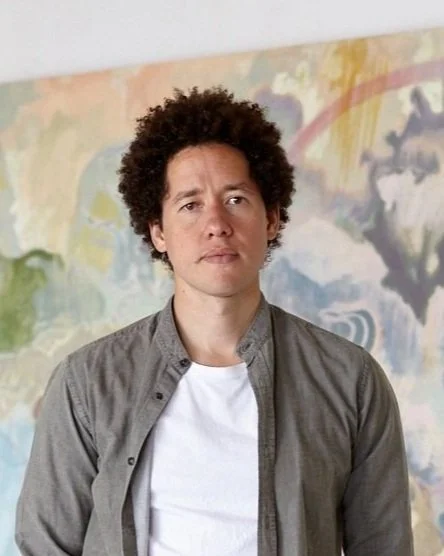Michael Armitage
born 1984, Nairobi, Kenya
Michael Armitage RA is a Kenyan/British painter who lives and works between London and Nairobi. With a Kikuyu mother, he spent his childhood in East Africa before training as an artist in Britain. He was elected a Royal Academician in the category of painting. Armitage is the founder of the Nairobi Contemporary Art Institute, a non-profit platform established in 2021 and directed by Ayako Bertolli.
Armitage’s practice involves painting in oil on Lubugo, a traditional bark cloth from Uganda. The cloth is produced by beating the bark over several days to create a natural material which, when stretched taut for painting, has occasional holes and coarse indents. Armitage first came across the material used as placemats for sale at a tourist stall, robbed of its traditional meaning for commercial profit. The images he paints on the bark weave together his experiences in Kenya with current events in East Africa and references to European art history and mythology. These works are influenced by European artists such as Paul Cézanne, Francisco de Goya, and the 16th-century Italian Titian but inspired by African artists such as Jak Katarikawe, Chelenge van Rampelberg and Meek Gichugu.
Applying the paint in layers, Armitage scrapes, revises and repaints his compositions. The backdrops are the urban and rural landscapes of East Africa and the animals which roam in them, as well as images from advertising. Like Phokela, he contrasts the rich colours of this context and refinement of his brushwork with the harsh realities of political strife and divisions between rich and poor. This creates beautiful but nightmarish images which, like Goya’s, blend the every day with the absurd. Mydas (2019), for example, sets the Greek myth of King Midas, who was cursed with turning everything – including food – to gold in Northern Kenya. He describes this setting as“an area that’s prone to drought, where there are a lot of very difficult day-to-day lives and politics, and where you could almost imagine somebody trying to give up everything for a solution—no matter how complicated and problematic…”
Armitage claims that ‘Painting is a way of thinking through something, trying to understand an experience or an event a little better and trying to communicate something of the problem to others’. The painting Necklacing (2016) was inspired by the Kenyan General Elections, which were then coming up. A naked man with a tyre around his neck is framed by two lines where the Lubogo has been sown together. The crowds behind him are like carnival revellers, with wigs and masks, but they hold slings which point to the potential for violence to erupt at any moment.
Armitage’s work has been exhibited in institutions such as The Museum of Fine Arts, Houston and Tate Modern, London, and the Norval Foundation in Cape Town. It is part of many permanent collections, including the Art Institute of Chicago, National Galleries of Scotland, Edinburgh and the Nairobi Contemporary Arts Institute (NCAI).

